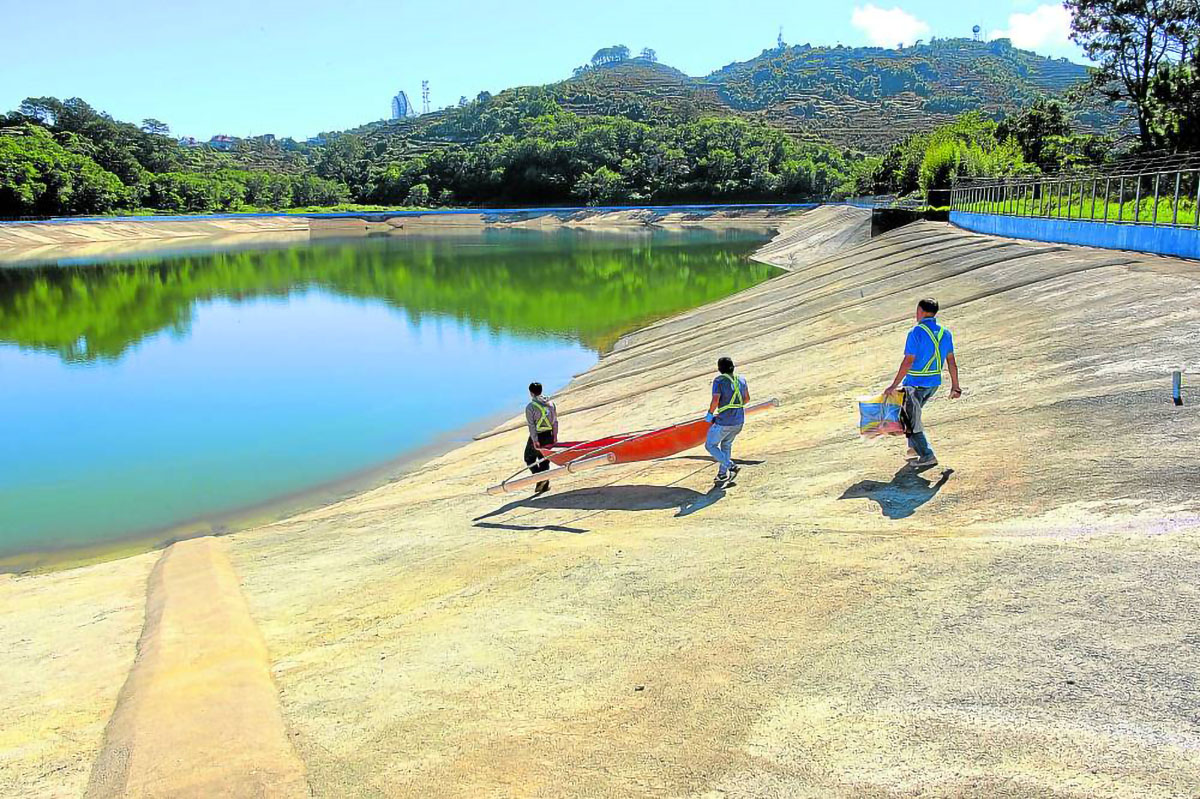
RAIN HARVEST When the Americans designed and built Baguio in the early 1900s, the colonial engineers also observed the high volume of rains in the city, prompting the construction of the Mt. Sto. Tomas rain basin, shown in this January photo. The Baguio Water District recently expanded this catchment facility, which can now hold 700,000 cubic meters of rain. —NEIL CLARK ONGCHANGCO
BAGUIO CITY—The prolonged dry spell brought about by the El Niño weather phenomenon has strained the city’s aquifers, prompting the local government to again resort to a water conservation drive until rains replenish the water table.
Even tourists are being asked to moderate their use of tap water, said city administrator Bonifacio dela Peña at a briefing on Wednesday.
According to Dela Peña, the strain on supply has become critical and will be a crisis in a worst-case scenario when strong rains do not fall by August.
But predictive models put out by the government weather bureau suggest that El Niño may weaken by the end of May and there is a high chance that a La Niña phenomenon characterized by high rainfall volume will affect Baguio and the rest of the country by July and August.
Baguio, because of its mountain terrain, is one of the communities that receive high rainfall, or an average “annual precipitation load of 4,000 millimeters of rain,” according to the Asian Development Bank’s 2023 profile of the city’s climate resilience and low-carbon urban development.
The city government has been studying natural catchment basins like the City Camp Lagoon for containing, treating and distributing rainwater delivered there from higher elevations in Baguio, Dela Peña said.
Baguio also relies heavily on the 2-hectare rain basin built by American engineers on Mt. Santo Tomas, which was recently upgraded to accommodate 700,000 cubic meters (cu m) of rainwater. A cubic meter of water is equivalent to 1,000 liters or about five drums of water.
But Mayor Benjamin Magalong has again explored the possibility of securing bulk water services from big developers to solve Baguio’s perennial water problem, although residents would need to absorb high tariffs ranging from P100 to P139, he said.
Baguio, one of the country’s top tourist destinations, has been rationing its water supply since the 1980s, because of its rapid population growth and overdevelopment.
“There is a direct correlation between the depleted tree population and the inability to recharge the aquifer quickly,” said Dela Peña, a geodetic engineer.
Trees, he said, help the soil absorb and discharge runoff rainwater beneath the surface.
However, expanded settlements and widespread concreting in most parts of Baguio have left its remaining watersheds and forestlands covering only 9.81 percent of the city’s 57 square-hectare territory, according to several studies.
The 2019 Baguio urban carrying capacity report has estimated that water resources for the current population (366,358 as of the 2020 census) have been breached since 2002 because the population threshold for water was 267,546 people.
This year, the Baguio Water District (BWD) will produce 46,423.88 cu m of water daily to fill the demand of 44,753 consumers; up from the 45,066.02 cu m it generated each day for 44,607 consumers in 2023, according to a BWD projection chart.
But unless population and migration are controlled by 2031, demand from a projected population of 57,953 would exceed supply (55,452 cu m), the utility said.
Extreme heat
BWD has yet to issue an official statement on the current water supply status, but an official of the utility, who asked not to be named in this report, says the city has more supply now because of newly developed sources, although demand has been high because of the extreme heat.
A few commercial deep wells that deliver water for a fee to augment tap water supplied by BWD have reported suffering low water pressure during the El Niño months, Dela Peña said.
“We have [commercial deep well operations] which have served Baguio for 30 years but have been depleted,” he said.
Rain harvesting is still a viable measure for sustaining Baguio’s water, and many of the city’s oldest households have been storing rainwater.
“But the long-term solution is bulk water, definitely,” Dela Peña said, noting that this would prevent the city aquifer from being depleted.
He said several bulk water proponents have suggested building a series of five pumping stations that would deliver water to the city.
Dela Peña did not name these proponents but said consumers would have to bear the cost of pumping up water, which could entail as much as P139 per cu m, which is higher than the current P40 rate.